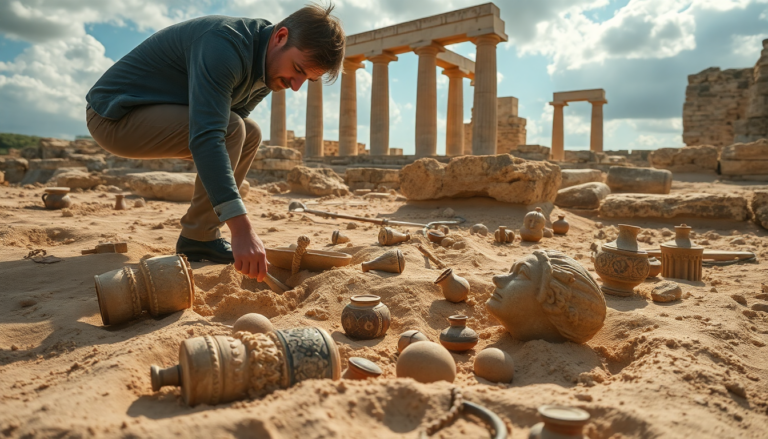Argomenti trattati
Imagine walking through the sands of time, only to stumble upon a hidden treasure trove of history. This isn’t just a fantasy; it’s the reality that a team of archaeologists recently faced when they unearthed an ancient sanctuary dedicated to Apollo in Cyprus. After being lost for over a century, the site is now revealing its secrets, including priceless statues and artifacts that tell tales of rituals long forgotten.
The rediscovery of the sanctuary
It has been 140 years since German archaeologist Max Ohnefalsch-Richter first uncovered this site near the ancient city-kingdom of Tamassos. In the ensuing years, the excavation site was buried once more, fading into obscurity. Fast forward to 2021, when a dedicated team from the universities of Frankfurt and Kiel/Würzburg began to dig again. What they have uncovered is nothing short of breathtaking: large sections of the sanctuary, complete with structural foundations, a dedication courtyard, and over a hundred statue bases—many of them impressively large.
I remember when I first learned about archaeological digs, often romanticizing the image of dusty explorers unveiling ancient civilizations. Yet, this discovery is a perfect example of the blend of hard work and serendipity that defines archaeology. The thrill of finding something that was once lost to time is palpable, and you can almost feel the excitement of the team as they brush away centuries of sand to reveal what lies beneath.
Unveiling the treasures
Among the remarkable finds are fragments of statues that hint at the grandeur of ancient artistry. The sanctuary, located in the Frangissa valley near Pera Orinis, was once one of the wealthiest rural sanctuaries in the region. The colossal statues, some dating back to the archaic period (7th-6th century BC), are particularly noteworthy. Until now, the only known colossal representations from Frangissa were terracotta figures, like the famous “Colossus of Tamassos.” It’s fascinating to think about how these long-hidden sculptures might reshape what we know about ancient Cypriot culture.
But it’s not just the statues that are capturing attention. The archaeologists have also uncovered an array of votive offerings, including Egyptian amulets crafted from faïence and marbled glass beads. These artifacts suggest vibrant intercultural exchanges and highlight the sanctuary’s broader religious significance. It’s almost poetic—these objects, once used in sacred rituals, are now telling us their stories.
A glimpse into architectural advancements
In addition to the artistic treasures, the excavation has revealed significant architectural developments. A vast peristyle courtyard was constructed adjacent to the votive area, presumably for ritual banquets or symposiums. This discovery recontextualizes the sanctuary not only as a religious site but also as a social hub. It’s intriguing to envision gatherings of ancient worshippers sharing food and stories, their laughter echoing against the stone walls.
For the archaeologists involved, this moment is a golden opportunity to document and analyze architectural features that were hastily overlooked in the 19th-century excavations. You see, modern techniques and focused scholarly approaches are opening new doors—literally and figuratively—for understanding how these ancient structures functioned in their time.
Implications for future research
The implications of this discovery extend far beyond the excavation site. The fragments uncovered are likely to aid in restoring various statues currently housed in the Cyprus Museum and the Royal Ontario Museum in Toronto. Scholars now have the chance to piece together incomplete figures that have remained a mystery for over a century. It’s like finding a missing puzzle piece that enriches the entire picture.
As many know, archaeology is not just about digging up the past; it’s about connecting with it. This sanctuary, hidden for so long, may redefine a key chapter in Cypriot archaeological history. It’s a reminder that history is not static but rather an ongoing conversation, influenced by new discoveries and interpretations. Personally, I believe that every new find challenges our understanding and invites us to rethink what we thought we knew.
In a world so fast-paced and driven by technology, it’s essential to remember the roots of our humanity. The rediscovery of Apollo’s sanctuary is a testament to the enduring allure of history and the stories that lie in wait, just beneath the surface.
A journey worth taking
For those with a sense of adventure and a curiosity about the past, visiting this site in Cyprus could be an incredible experience. The thrill of being where history unfolded, of witnessing the remnants of ancient rituals, is a journey that transcends time. It ignites a passion for exploration, reminding us that there’s still so much to discover, learn, and appreciate.
So, whether you’re a seasoned traveler or someone just starting their journey, consider adding a visit to the newly rediscovered sanctuary of Apollo to your itinerary. Who knows what stories you might uncover, or what inspiration you might find in the echoes of the past?

